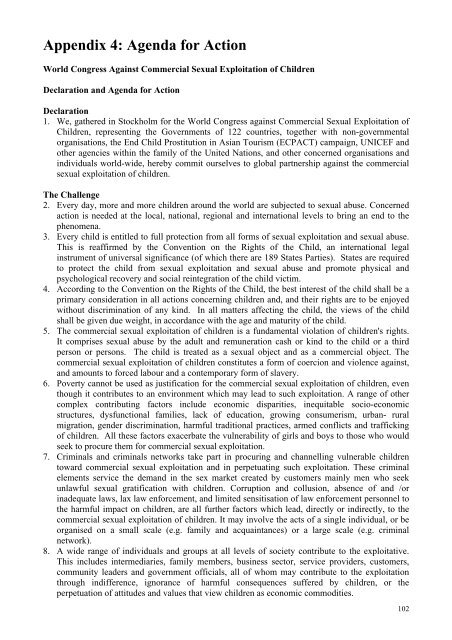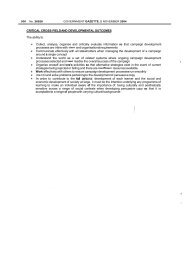The trafficking of children for purposes of sexual exploitation
The trafficking of children for purposes of sexual exploitation
The trafficking of children for purposes of sexual exploitation
You also want an ePaper? Increase the reach of your titles
YUMPU automatically turns print PDFs into web optimized ePapers that Google loves.
Appendix 4: Agenda <strong>for</strong> Action<br />
World Congress Against Commercial Sexual Exploitation <strong>of</strong> Children<br />
Declaration and Agenda <strong>for</strong> Action<br />
Declaration<br />
1. We, gathered in Stockholm <strong>for</strong> the World Congress against Commercial Sexual Exploitation <strong>of</strong><br />
Children, representing the Governments <strong>of</strong> 122 countries, together with non-governmental<br />
organisations, the End Child Prostitution in Asian Tourism (ECPACT) campaign, UNICEF and<br />
other agencies within the family <strong>of</strong> the United Nations, and other concerned organisations and<br />
individuals world-wide, hereby commit ourselves to global partnership against the commercial<br />
<strong>sexual</strong> <strong>exploitation</strong> <strong>of</strong> <strong>children</strong>.<br />
<strong>The</strong> Challenge<br />
2. Every day, more and more <strong>children</strong> around the world are subjected to <strong>sexual</strong> abuse. Concerned<br />
action is needed at the local, national, regional and international levels to bring an end to the<br />
phenomena.<br />
3. Every child is entitled to full protection from all <strong>for</strong>ms <strong>of</strong> <strong>sexual</strong> <strong>exploitation</strong> and <strong>sexual</strong> abuse.<br />
This is reaffirmed by the Convention on the Rights <strong>of</strong> the Child, an international legal<br />
instrument <strong>of</strong> universal significance (<strong>of</strong> which there are 189 States Parties). States are required<br />
to protect the child from <strong>sexual</strong> <strong>exploitation</strong> and <strong>sexual</strong> abuse and promote physical and<br />
psychological recovery and social reintegration <strong>of</strong> the child victim.<br />
4. According to the Convention on the Rights <strong>of</strong> the Child, the best interest <strong>of</strong> the child shall be a<br />
primary consideration in all actions concerning <strong>children</strong> and, and their rights are to be enjoyed<br />
without discrimination <strong>of</strong> any kind. In all matters affecting the child, the views <strong>of</strong> the child<br />
shall be given due weight, in accordance with the age and maturity <strong>of</strong> the child.<br />
5. <strong>The</strong> commercial <strong>sexual</strong> <strong>exploitation</strong> <strong>of</strong> <strong>children</strong> is a fundamental violation <strong>of</strong> <strong>children</strong>'s rights.<br />
It comprises <strong>sexual</strong> abuse by the adult and remuneration cash or kind to the child or a third<br />
person or persons. <strong>The</strong> child is treated as a <strong>sexual</strong> object and as a commercial object. <strong>The</strong><br />
commercial <strong>sexual</strong> <strong>exploitation</strong> <strong>of</strong> <strong>children</strong> constitutes a <strong>for</strong>m <strong>of</strong> coercion and violence against,<br />
and amounts to <strong>for</strong>ced labour and a contemporary <strong>for</strong>m <strong>of</strong> slavery.<br />
6. Poverty cannot be used as justification <strong>for</strong> the commercial <strong>sexual</strong> <strong>exploitation</strong> <strong>of</strong> <strong>children</strong>, even<br />
though it contributes to an environment which may lead to such <strong>exploitation</strong>. A range <strong>of</strong> other<br />
complex contributing factors include economic disparities, inequitable socio-economic<br />
structures, dysfunctional families, lack <strong>of</strong> education, growing consumerism, urban- rural<br />
migration, gender discrimination, harmful traditional practices, armed conflicts and <strong>trafficking</strong><br />
<strong>of</strong> <strong>children</strong>. All these factors exacerbate the vulnerability <strong>of</strong> girls and boys to those who would<br />
seek to procure them <strong>for</strong> commercial <strong>sexual</strong> <strong>exploitation</strong>.<br />
7. Criminals and criminals networks take part in procuring and channelling vulnerable <strong>children</strong><br />
toward commercial <strong>sexual</strong> <strong>exploitation</strong> and in perpetuating such <strong>exploitation</strong>. <strong>The</strong>se criminal<br />
elements service the demand in the sex market created by customers mainly men who seek<br />
unlawful <strong>sexual</strong> gratification with <strong>children</strong>. Corruption and collusion, absence <strong>of</strong> and /or<br />
inadequate laws, lax law en<strong>for</strong>cement, and limited sensitisation <strong>of</strong> law en<strong>for</strong>cement personnel to<br />
the harmful impact on <strong>children</strong>, are all further factors which lead, directly or indirectly, to the<br />
commercial <strong>sexual</strong> <strong>exploitation</strong> <strong>of</strong> <strong>children</strong>. It may involve the acts <strong>of</strong> a single individual, or be<br />
organised on a small scale (e.g. family and acquaintances) or a large scale (e.g. criminal<br />
network).<br />
8. A wide range <strong>of</strong> individuals and groups at all levels <strong>of</strong> society contribute to the exploitative.<br />
This includes intermediaries, family members, business sector, service providers, customers,<br />
community leaders and government <strong>of</strong>ficials, all <strong>of</strong> whom may contribute to the <strong>exploitation</strong><br />
through indifference, ignorance <strong>of</strong> harmful consequences suffered by <strong>children</strong>, or the<br />
perpetuation <strong>of</strong> attitudes and values that view <strong>children</strong> as economic commodities.<br />
102
















